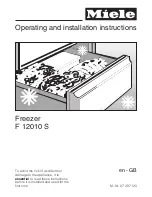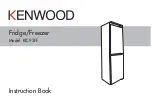
Freezing foods / storing frozen foods
Page GB-14
Suitable packaging
Packaging is important when freezing. This
will protect against oxidation, penetration by
microbes, transfer of odours and flavourings
and drying out (freezer burn).
• Only use packaging material that is
strong, impermeable to air and liquid, not
too stiff and labelled. It should be desig-
nated as suitable for freezer use.
Portions
• Create flat portions if possible; these
freeze through to the core faster.
• Expel the air from the freezer bag as this
causes the contents to dry out and takes
up space.
• Use plastic clips, rubber bands or adhe-
sive tapes to seal.
• Fill liquid containers no more than ¾ full
because liquids expand when frozen.
• Do not store glass or metal containers of
liquid. The containers could break.
• Only freeze high-proof alcohol that is
tightly sealed.
• Label the frozen food by type, quantity,
amount and expiry date. Use waterproof
marker pens or adhesive labels wherever
possible.
How to pack the freezer properly
Maximum freezing capacity
Adhere to the maximum freezing capacity.
You will find information about “Freezing ca-
pacity in kg/24 hours” in the product fiche on
page GB-28.
Freeze smaller quantities
• up to 2 kg: Once the freezer temperature
is -18° C, you can freeze fresh, room-tem-
perature foods.
• over 2 kg: Keep fresh goods out of con-
tact with existing frozen foods as they
could start to thaw. If contact with stored
food can not be avoided, we recommend
that you create a cold reserve in the
freezer before freezing the fresh goods.
The temperature in the freezer briefly rises af-
ter placing fresh goods inside. After 24 hours,
the goods are frozen to the core.
Storing frozen food
The deep-freeze chain must not be broken
between the manufacturer and your freezer.
The temperature of the frozen food must al-
ways be at least -18° C.
Therefore, do not buy any goods that
– are in frosty, over-icy chests.
– are stacked above the stipulated high-load
marker.
– partially clumped (particularly easy to iden-
tify with berries and vegetables).
– have snow and juice traces.
• Transport frozen foods in special styro-
foam boxes or insulated bags.
• Observe the storage conditions and times
on the packaging
Summary of Contents for HEKS 14454GA2
Page 60: ...Technical specifications ...
















































